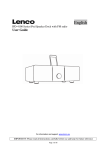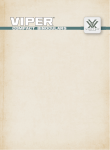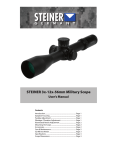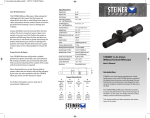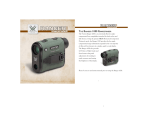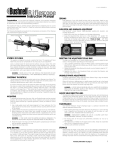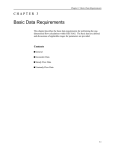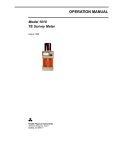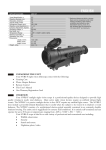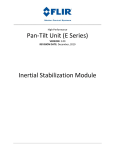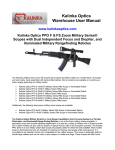Download - Vortex Optics
Transcript
5-20x50 Riflescope At Vortex Optics, the need for high-performance, precision optics is the driving force behind all that we do. That’s why we carefully built the Razor HD riflescope to provide shooters with the ultimate long range tactical riflescope. Built on an incredibly tough one piece 35mm main tube and using a state-of-the-art optical system and erector mechanism, the Razor 5–20x50 delivers superior accuracy and rugged reliability under the harshest conditions. ® Specifications . . . . . . . . . . . . . . . . . . 2 Adjustments . . . . . . . . . . . . . . . . . . . 4 Mounting . . . . . . . . . . . . . . . . . . . . . 10 Maintenance . . . . . . . . . . . . . . . . . . 18 Troubleshooting . . . . . . . . . . . . . . . . 19 Vortex Service and Repair Policy . . . . . . 20 1 Razor 5–20x50 Riflescope Specifications Waterproof Fogproof Length Mounting Length Weight Eye Relief Field of View Recoil Tested Battery (Eyepiece) Yes Argon gas purging 15.8 inches (402 mm) 6.9 inches (175 mm) 35.2 ounces (1000 g) 3.9 inches (100 mm) 5x: 22.0 feet /100 yards (4.2°) 20x: 5.76 feet /100 yards (1.1°) Rated for .50 BMG CR2032 2.5” (64mm) 2.9” (74mm) The Vortex Razor HD 5-20x50 Riflescope RZR Zero Stop and Elevation Adjustment Knob Windage Adjustment Knob MagView 1.74” (43mm) Illumination Knob and Battery Cover Objective Lens (Sunshade) 2.33” (58mm) 4.0” (102mm) 6.9” (175mm) 4.9” (125mm) 4.0” (102mm) Side Parallax Focus 15.8” (402mm) Razor HD Models MOA MRAD Adjustment Graduation 1/4 MOA .1 MRAD Elevation Adjustment 125 MOA 36 MRAD Windage Adjustment 125 MOA 36 MRAD Travel Per Rotation 15 or 25 MOA 5 or 10 MRAD Magnification Adjustment Ring Reticle Focus Radius Bar (3) Turret Cap Retaining Screws Zero Reference Line 2 4 3 5 Riflescope Adjustments Windage and Elevation Adjustments MOA Adjustments Vortex 5–20x50 Razor riflescopes incorporate precision finger adjustable elevation and windage knobs with audible and tactile clicks. Elevation To make adjustments: Adjustment Knob Most shooters are familiar with the minute–of-angle (MOA) system commonly used in hunting riflescopes. MOA measurements are based on degrees and minutes: 360 degrees in a circle, 60 minutes in a degree, for a total of 21,600. When comparing MOAs and mrads, 3.44 MOAs are equal to 1 mrad. These angular measurements are used for ranging and correcting for the bullet’s trajectory drop in riflescopes. 1.Turn the adjustment knob in the appropriate direction: Up/Down or Left/Right as indicated by the arrows. 2.Move the knobs in the direction you wish the bullet’s point-of-impact to change. Windage Adjustment Knob Depending on which version you have purchased, your Razor 5–20x50 riflescope will feature adjustments scaled in MOAs or mrads. If you are unsure of which scale is used, reference the top of the adjustment turret. If the adjustment is in MOAs, the turret will display “1 Click = ¼ MOA”. If the adjustment is in mrads, the turret will display “1 click = 1/10 mrad”. 4 6 Each click will move the point-of-impact 1/4 MOA. 1/4 MOA closely corresponds to .26 inches at 100 yards, .52 inches at 200 yards, .78 inches at 300 yards, etc. Example: At a 100 yard sight-in distance, it will take four clicks of the knob to move a bullet’s point-of-impact 1.05 inches. MRAD Adjustments The milliradian (mrad for short) is a form of angular measurement similar in concept to a degree although much finer. A degree is 1/360 of a circle; a milliradian is 1/6283 of a circle. Each click will move the point-of-impact 1/10 mrad. 1/10 mrad equals .36 inches at 100 yards (1 cm at 100 meters), .72 inches at 200 yards (2 cm at 200 meters), 1.08 inches at 300 yards (3 cm at 300 meters), etc. Example: At a 100 yard sight-in distance, four clicks will move the bullet’s point-of-impact 1.44 inches. At 100 meters, four clicks will move the point-of-impact four centimeters. 5 7 Reticle Focusing Parallax Adjustment Vortex Razor riflescopes use a fast focus eyepiece designed to quickly and easily adjust the focus on the riflescope’s reticle. The Razor HD 5–20x50 riflescope uses a side focus parallax adjustment which, when properly set, eliminates parallax errors. Properly setting a side focus parallax adjustment is a quick procedure. When properly set, the target image should be sharp and crisp. Try to make this particular adjustment quickly, as the eye will try to compensate for an out-of-focus reticle. To set the parallax: 1.First, be sure the reticle is correctly focused (see Reticle Focusing). Adjust the reticle focus To adjust the reticle focus: 1.Look through the riflescope at a blank white wall or up at the sky. 2.Turn the eyepiece focus knob in or out until the reticle image is as crisp as possible. Note: Once this adjustment is complete, it will not be necessary to re-focus every time you use the riflescope. However, because your eyesight may change over time, you should re-check this adjustment periodically. 2.As accurately as possible, match the yardage number (distance you are shooting) on side focus parallax adjustment knob to the indicator arrow on the scope body. 3.Check the setting for accuracy by moving your head back and forth while looking through the scope. The setting is correct if there is no apparent movement between the reticle and target. If there is apparent movement, adjust the focus knob slightly until the movement is eliminated. Adjust the side parallax knob Parallax is a phenomenon that results when the target image does not quite fall on the same optical plane as the reticle within the scope. When the shooter’s eye is not precisely centered in the eyepiece, there can be apparent movement of the target in relation to the reticle, which can cause a small shift in the point of aim. Parallax error is most problematic for precision shooters using high magnification. 6 8 7 9 Turret Rotation Variable Power Adjustments Vortex Razor riflescopes incorporate the Radius Bar to visually assist in keeping track of turret rotations. By watching the position of the bar while making elevation adjustments, the shooter is able to quickly track full, half and quarter rotations. To get the most benefit from the Radius Bar, the “0” mark on the turret must be indexed with the zero reference line on turret post. To change magnifications, turn the magnification ring to the desired level. The Vortex MagView system will provide a low light reference for magnification level. Radius Bar Illumination Adjustments The Vortex Razor HD 5–20 x 50 riflescope uses a variable intensity reticle illumination system to aid in low light performance. To activate the illumination, rotate the adjustment knob in a clockwise direction. The illumination knob allows for 11 levels of brightness intensity; an off click between each level allows the shooter to turn the illumination off and return to a favored intensity level with just one click. The top setting (11) is visible in the daytime, depending on the background color. Settings below 11 are for low light use when the user’s eyes have adjusted to lower light levels. Lowest settings are for use with night vision devices. Battery Cap To change batteries: 1.Unscrew the outer cap with a coin. 2.Remove the CR2032 battery. RZR Zero Stop Adjustment Vortex Razor 5–20x50 riflescopes incorporate the RZR Zero Stop feature. After the rifle is sighted in, the RZR Zero Stop allows fast, easy return to the original zero point when large multi-revolution elevation corrections have been dialed into the riflescope. Without a zero stop, the shooter must pay very careful attention when dialing large corrections needing multiple revolutions of the elevation knob. If the shooter loses track of the number of revolutions, the original zero point may become lost. Because of the RZR Zero Stop, the elevation knob on Vortex Razor scopes can be quickly spun back to the original zero without having to carefully count revolutions. Once the RZR Zero Stop is set, the elevation knob will stop turning at the original zero point when being returned from a temporary elevation correction. Learn how to adjust the RZR Zero Stop in the Bore Sighting and Range Sight-in sections. 3.Replace with a new CR2032 battery. 8 10 MagView 9 11 Riflescope Mounting To get the best performance from your Vortex Razor riflescope, proper mounting is essential. Although not difficult, the correct steps must be followed. If you are unsure of your abilities, it would be best to use the services of a qualified gunsmith. Centering of the Reticle The Vortex Razor HD riflescope is pre-set from the factory with the reticle in the center of the adjustment ranges. This is the best position to begin sight-in. If you have changed the settings and wish to reset the reticle to the center, this can be done easily: 1.Loosen the elevation turret cap retaining screws and remove the elevation cap. 2.Loosen the eleveation zero stop lock screws. 3.Turn the windage and elevation turrets clockwise until stopped. Rings and Bases Mount an appropriate base and matching rings to your rifle according to the manufacturer’s instructions. The Vortex Razor 5–20x50 riflescope requires 35mm rings. Vortex Optics highly recommends using the matched Vortex Optics Omega 35mm precision ring sets which may be purchased Use 35mm rings for the Razor 5–20x50 from an authorized Vortex riflescope dealer. These rings will mount to any quality Weaver or Picatinny type base. If using aftermarket rings, use the lowest ring height that will give complete clearance of scope and rifle—avoiding any contact with barrel, receiver, bolt handle or any other part of the rifle. A low mounting will help assure proper cheek weld, aid in establishing a solid shooting position, and promote fast target acquisition. 4.Turn windage and elevation turrets counter-clockwise 4.25 full rotations to approximately center the reticle. At this point, the riflescope is ready for bore sighting (see Bore Sighting section). 10 12 11 13 Eye Relief and Reticle Alignment Bubble Level Place the riflescope on bottom ring halves and loosely install the upper ring halves. Before tightening the scope ring screws, adjust for maximum eye relief to avoid injury from recoil: After the riflescope is in the rings and the reticle matches the vertical axis of the rifle, the bubble level may be mounted Vertical Reference to the riflescope tube. Attach the level to a location on the scope tube that allows Bubble Level good visibility while in shooting position and does not block view of parallax or windage knobs. Most shooters will prefer mounting the level on the forward section of the riflescope tube. 1.Set the riflescope to the middle of its magnification range. 2.Slide the riflescope as far forward as possible in the rings. While viewing through the riflescope in a normal shooting position, slowly slide the riflescope back towards the shooter’s face—paying attention to the field of view. Just as the full view becomes visible, stop. 3.Without disturbing the front-back placement, rotate the riflescope until the vertical crosshair exactly matches the vertical axis of the rifle. Use a reticle leveling tool, hanging weight on a rope (see next page), or an adjustable set of feeler gauges for this procedure. 4.After aligning the reticle, tighten and torque the ring screws down per the manufacturer’s instructions. Example of Squaring the Riflescope Use of an adjustable set of feeler gauges between a one-piece base and flat bottom section of the riflescope to square the riflescope (and reticle) to the base. Confirm the vertical orientation of the reticle. 1.Confirm the vertical orientation of the reticle by hanging a weight from a heavy cord at a distance out in front of the riflescope. 2.Visually level the bubble between lines and tighten screws using thumb and forefinger on short end of hex wrench. 14 12 15 13 Bore Sighting and RZR Zero Stop Preparation Initial bore sighting of the riflescope will save time and money at the range. This can be done by removing the bolt and sighting through the barrel on a bolt action rifle, or using a mechanical or laser bore sighter. Preparing the RZR Zero Stop for setting: 1.Begin by turning the elevation knob clockwise until it stops. 2.Loosen, but do not remove, the three elevation turret cap retaining screws. 3.Lift the elevation turret cap up and off the turret. This will reveal the scale markings to be used for sight in. 4. Next, loosen, but do not remove, the three elevation zero stop lock screws. Loosen Zero Stop Lock Screws Loosen Elevation Cap Screws Remove Elevation Turret Cap Note: You will not feel “clicks” as the elevation knob is adjusted—this is normal. The “clicks” will return after final zero stop is set at the rifle range. Use the graphic number scale to track adjustments. Sight-in Adjustment Scale Bore sighting a bolt action rifle without a mechanical or laser bore sighter: 1. Place the rifle solidly on a rest and remove the bolt. 2.Sight through the bore at a target approximately 100 yards away. 3.Move the rifle and rest until the target is visually centered inside the barrel. 4.With the target centered in the bore, make elevation and windage adjustments until the reticle crosshair is also centered over the target. Note: No initial adjustments are needed on the windage knob. If using a mechanical or laser bore sighter, set up according to manufacturer instructions. Make windage and elevation adjustments until the reticle crosshair is aligned with the adjustment pattern or laser dot. 16 14 Important Do not re-tighten elevation zero stop lock screws or replace the turret cap at this time; these will be tightened after the final sight-in. 17 15 Range Sight-In and RZR Zero Stop Set After obtaining satisfactory zero, set the RZR zero stop: After the riflescope has been bore-sighted, final sight-in and RZR Zero Stop set should be done at the range using the exact ammunition expected to be used while shooting. Sight in and zero the riflescope at the preferred distance. 100 yards is the most common zero distance, although a 200 yard zero may be preferred for long distance applications. 1.Re-tighten the three zero stop lock screws. Do not over tighten: thumb and forefinger on the short end of supplied hex wrench will be sufficient. 1.Be sure to follow all safe shooting practises. Before shooting, be sure the reticle is in focus (see Reticle Focus Adjustment). 2.At your preferred zero distance, fire a three-shot group as precisely as possible. 2.Replace elevation turret cap, being sure to align “0” mark on cap with the zero reference line on scope body. Push the cap straight down and avoid turning while doing this. 3.Be sure the cap is fully down and re-tighten elevation cap retaining screws. Do not overtighten: using thumb and forefinger on short end of hex wrench will be sufficient. Note: To re-zero for a different load, repeat complete bore sighting and range sight-in procedures. It is important to always begin any sight-in adjustments by turning elevation turret clockwise until fully stopped. 3.Next, adjust the reticle to match the approximate center of the shot group (see section on Windage and Elevation Adjustment). As previously noted in the section on bore sighting, the elevation turret cap turret should be removed and zero stop lock screws should be loosened. Re-Indexing Zero Mark on Windage Knob 4.If the rifle is very solidly mounted and cannot be moved, simply look through the scope and adjust the reticle until it is centered on the fired group. If desired, the windage knob may be re-indexed to zero after sight-in. This will allow an easy return to the zero point if temporary windage corrections are dialed in the field. 5.Carefully fire another three-shot group and see if the bullet group is centered on the bullseye. 1.After completing the final sight-in, fully loosen the three windage turret cap retaining screws and carefully pull the turret cap straight off. Re-position with the “0” mark on the cap aligned with the zero reference line on the turret post and push the cap straight down. Avoid rotating while pushing down. If necessary, make another adjustment to the riflescope and fire another group to verify zero. This procedure can be repeated as many times as necessary to achieve a perfect zero. 16 18 2.Be sure the cap is fully down and re-tighten windage knob retaining screws. Do not overtighten: using thumb and forefinger on short end of hex wrench will be sufficient. 17 19 Maintenance Troubleshooting Cleaning Please check the following items prior to returning a riflescope for service. The Vortex Razor riflescope requires very little routine maintenance other than periodically cleaning the exterior lenses. The exterior of the scope may be cleaned by wiping with a soft, dry cloth. When cleaning the lenses, be sure to use products that are specifically designed for use on coated optical lenses. • Be sure to blow away any dust or grit on the lenses prior to wiping the surfaces. • Using your breath, or a very small amount of water or pure alcohol, can help remove stubborn things like dried water spots. Lubrication All components of the Vortex Razor HD are permanently lubricated, so no additional lubricant should be applied. If possible, avoid exposing your Vortex riflescope to direct sunlight or any very hot location for long periods of time. Note: Other than to remove the turret caps, do not attempt to disassemble any components of the riflescope. Disassembling of riflescope may void warranty. 18 20 Many times, problems thought to be with the scope are actually mount problems. Verify use of correct base and rings for the rifle and that these are correctly oriented and tightened. The scope should not twist or move in the rings. Insufficient windage or elevation adjustment range can indicate an incorrect base, alignment problems with mount holes drilled in base or rifle’s receiver, or alignment problems with barrel and receiver. If the rifle is failing to group well, there are several things to easily check: • Be sure the rifle’s action is bedded correctly, and all mounting screws are properly tightened. • The rifle’s barrel and action should be clean and free of excessive oil or copper fouling. • Also, some rifle/ammunition combinations simply don’t work well together—try shooting different ammunition and see if accuracy improves. • Over torquing rings. 19 21 The VIP Warranty We build optics based on our commitment to your absolute satisfaction. That’s why Vortex products are unconditionally guaranteed and we make this Very Important Promise to you—a Very Important Person. Rest assured that in the event your Razor HD riflescope becomes damaged or defective, Vortex Optics will repair or replace the riflescope at no charge to you. Call Vortex Optics at 800-426-0048 or e-mail [email protected] for prompt, professional, and friendly service. Unconditional Lifetime Warranty Vortex Optics 2120 West Greenview Drive Middleton, Wisconsin 53562 USA Visit vortexoptics.com for more information. Canadian customers may visit vortexcanada.net for customer service information. Note: The VIP warranty does not cover theft, loss, or deliberate damage to the product. US Patent 7,937,879 US Patent 7,958,665 Dual Use: Shooting Tactical / Hunting 20 RZR-52000-13A © Vortex Optics usa














